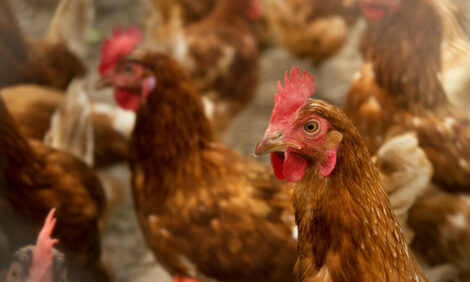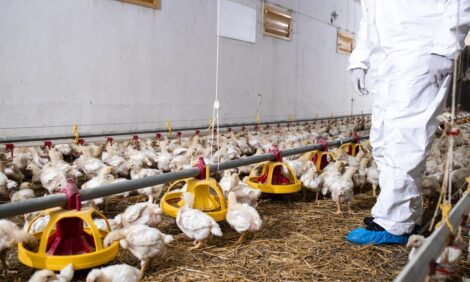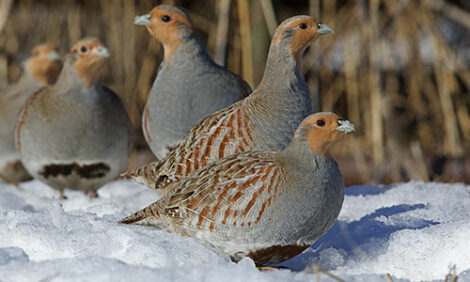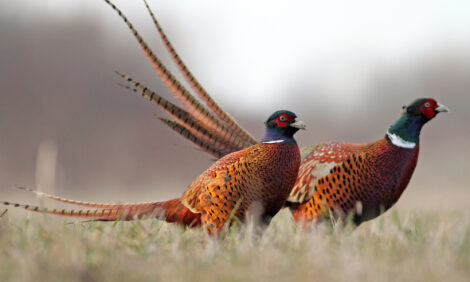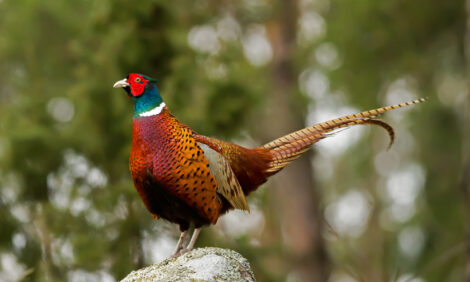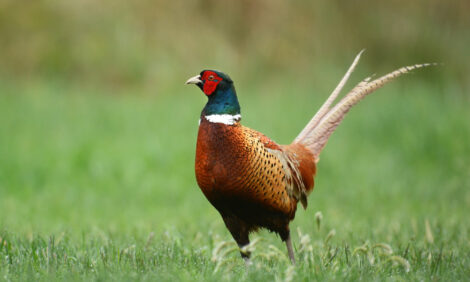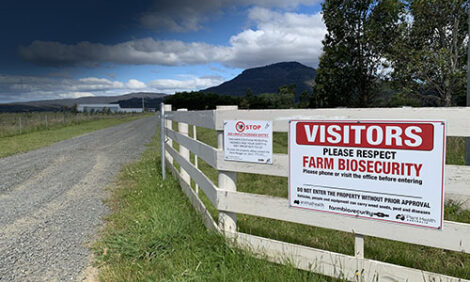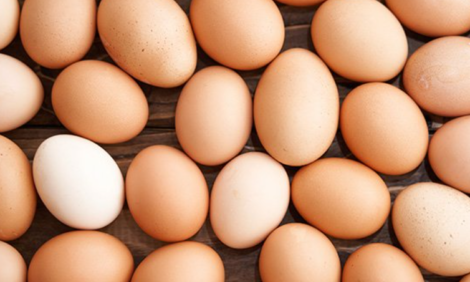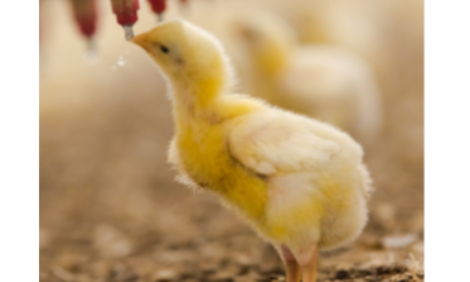



US Poultry Industry Manual - Production cycles for backyard poultry
Learn more about breeding seasons, fighting season, show schedules, movements, moltingPart of Series:
< Previous Article in Series Next Article in Series >
Editor's Note: The following content is an excerpt from Poultry Industry Manual: The Foreign Animal Disease Preparedness and Response Plan (FAD PReP)/National Animal Health Emergency Management System (NAHEMS) Guidelines which is designed to provide a framework for dealing with an animal health emergency in the United States. Additional content from the manual will be provided as an article series.
Breeding flocks and hatcheries
Many chickens, ducks and other species raised by individuals in backyards are obtained from the local feed store, usually in the spring around Easter. Many feed stores have baby chicks or other baby poultry for sale at this time, but may not have them available during the remainder of the year. Similarly, there are various breeding flocks that offer baby poultry for sale during most, if not all, of the year.
Some larger source flocks operate their own hatchery and will ship birds anywhere in the country by overnight courier. Feed stores may obtain their baby birds from any available source, including local breeder flocks, commercial hatcheries, or anywhere birds are available. Consultation with the store owner or manager should reveal the sources of birds, if it is necessary to trace or to conduct surveillance for disease control.
Breeding seasons, fighting season, show schedules, movements, molting
As previously indicated, most baby poultry hatchlings are available in the spring, but larger firms make the birds available year round. For gamefowl chickens, the usual breeding season begins in January and lasts for about 3 months. Gamefowl chicks are raised for about a year before they become breeding stock.
Fighting cocks (often called battle cocks) often are culled breeders that are available for sale through local dealers or directly at local swap meets. The fighting season, commonly referred to as “playing,” begins on Thanksgiving Day and continues until the following August.
The usual molting time for gamefowl extends from July to November. During the molt, battle cocks are more difficult to handle and are not often moved during this time. Molting should be completed by November before the cockfighting season begins.
Husbandry practices for backyard poultry
Housing and containment
A wide variation of housing and many methods for containment of poultry may be observed in the backyard setting. Traditional chicken houses of various designs and sizes are commonly used for backyard poultry. The housing type may also vary with the type of bird it serves. Chickens will often roost in trees, if accessible. Sometimes corral fences, haystacks, sheds, barns, junk piles, and most anything that will suit the birds may be used for roosting.
Waterfowl may prefer to roost on the ground nearwater, or inside a building depending on options available to them. Gamefowl often are kept as “trios,” a breeding group of 1 rooster and 2 hens, that are maintained in a separate housing unit. Many of these units may be arranged in a “row house” type of layout. Gamefowl roosters must be kept individually or they may be separated by being tethered by a strong cord attached to one leg. Keeping gamefowl at a distance to prevent physical contact with one another is necessary to prevent fighting.
Gamefowl cocks often are housed in used barrels or small A-frame structures tethered to a small stake driven into the ground. In other arrangements, gamefowl cocks may be maintained in individual cages most frequently with an opaque divider such as plywood or similar material separating the cages. Also, it is common to find poultry, and particularly gamefowl, housed in stables originally intended for horses which have been converted for use as chicken houses. Sometimes birds, and other types of livestock, may be housed inside industrial buildings in urban areas without any outward appearance that birds are present inside.
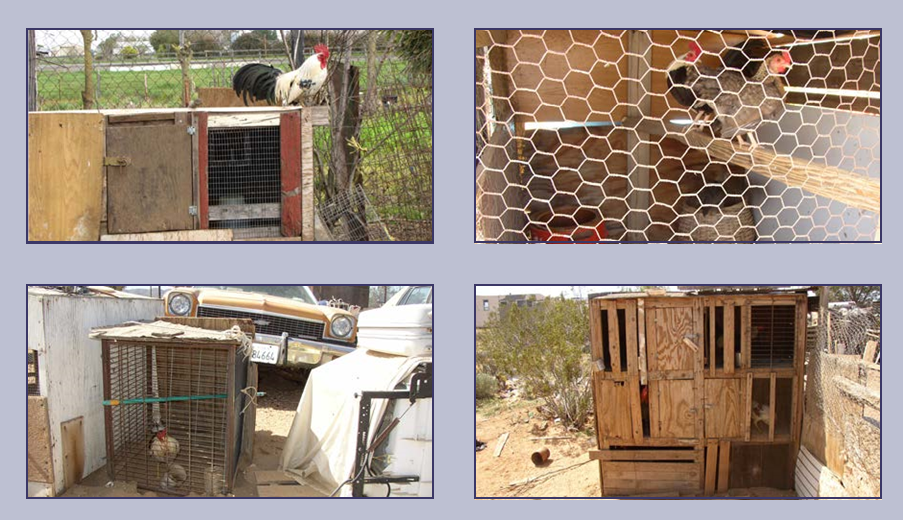
Feeding and Watering Systems
Depending on the numbers of birds and the type of housing in which birds are kept, feed and water may be dispensed in almost any type of container imaginable. Usually pans, bowls, or used containers of all sorts and sizes are used. Depending on the facility, this may also include any of the many commercially available feed or water dispensers or containers and even automated systems designed for chickens or other types of birds.
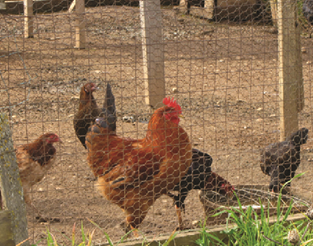
Feed sources and delivery
For the most part, feeds and other supplies are obtained at the local feed store and taken to the backyard facility in the owner’s vehicle. Larger backyard facilities may have feed, usually in bags, delivered to the backyard by a feed
store vehicle. Gamefowl breeders sometimes have feeds specially formulated at a feed mill or ordered through a local feed store and delivered to the facility by a store vehicle or their own vehicle. Once feed arrives at the backyard facility, it is commonly transported by wagon, wheelbarrow, by hand, or placed into self-feeders. Feeds utilized by gamefowl breeders include various supplements and other feed additives (including boiled eggs) in a quest to provide optimal growth rations and to produce the best possible gamefowl.
Health care
Backyard flock owners rarely rely on a veterinarian for avian health issues. The Poultry ’04 study found that only 2.9% of backyard flocks utilized veterinary services, but as flock size increased, the percentage of flocks using veterinary services also increased. Vaccination was practiced by only 2.8% of backyard flocks, but also increased with flock size (3,4). Cost of veterinary services is likely to be the greatest deterrent to flock owners, but low usage also may be partially explained by limited numbers of avian veterinarians and even fewer numbers of poultry veterinarians who are available to assist backyard poultry owners with health issues for their birds. As a result, many owners simply rely on their own judgment, product advertisements in trade journals or poultry magazines, the internet, and mostly advice from feed store operators, other breeders, farm advisors, their neighbors and any others whom they think may have the answers they need about avian health issues.
Another option for backyard poultry owners seeking avian health information and advice may be to take birds to a veterinary diagnostic laboratory, such as the California Animal Health and Food Safety Services Laboratory where a professional diagnosis can be obtained. In the California system, this diagnosis is free of charge to poultry “hobbyists,” that is, those with flocks of fewer than one thousand birds. Some laboratories will accept shipments sent by bus but owners should be sure to telephone ahead for shipping instructions.
Marketing
Backyard producers may market their products such as eggs and live birds by “word of mouth” advertising in the local area. More commonly, marketing is done at the local swap meet, auction, or farmers market or by road signs in front of the residence. In other cases, advertising by internet website or in trade journals and newspapers is utilized.
Manure disposal
Methods for disposal of poultry waste may vary depending on how many birds are kept and the amount of space available. In backyards with large spaces and few birds (pasture poultry system), it may be acceptable to let the manure dissipate into the soil. In many cases, the space and numbers of poultry necessitate collection and disposal of waste by other means. In some cases, it may be suitable to rake up the manure and dispose of it by placing it in the household trash container. Larger quantities of waste may necessitate disposal by other means. Composting and/or application to landscaping or gardens are generally acceptable manure disposal methods. Backyard poultry owners should check local ordinances for restrictions on methods for disposal of poultry waste in their area.
Disposal
Mortalities from backyard poultry operations also present a disposal issue in addition to manure disposal. Small holdings that only have the occasional dead bird may dispose of dead birds by placing them into household trash, provided that the waste collection authority is willing to accept this material. Composting dead poultry has become one of the preferred methods. If done properly, composting is a sanitary, odor-free, and efficient method to dispose of dead poultry and it produces a useful product at the end of the process. In some locations, laws may permit burial on site. Incineration is another acceptable method, but may not be practical or permitted in certain locations due to laws restricting burning. Rendering is an acceptable method for disposal of dead poultry, but rendering facilities are frequently reluctant to accept poultry carcasses. Over recent years, rendering companies have declined substantially in numbers and in the areas they service. This disposal method may be difficult to find and is unlikely to be an option for the majority of backyard poultry facilities.
Record keeping
Record keeping methods for backyard poultry operations have been discussed previously in section 5.2.2 (Business structure) on page 154.
Reference: "USDA APHIS | FAD Prep Industry Manuals". Aphis.Usda.Gov. 2013. https://www.aphis.usda.gov/aph...
The manual was produced by the Center for Food Security and Public Health, Iowa State University of Science and Technology, College of Veterinary Medicine, in collaboration with the USDA Animal and Plant Health Inspection Service through a cooperative agreement.







